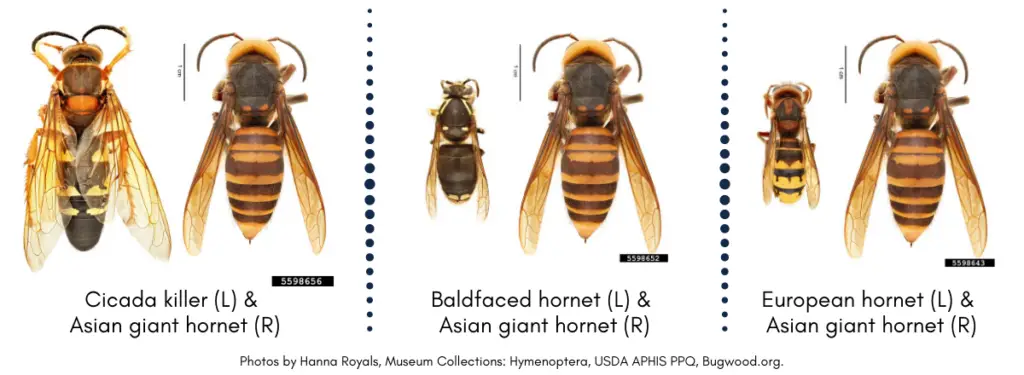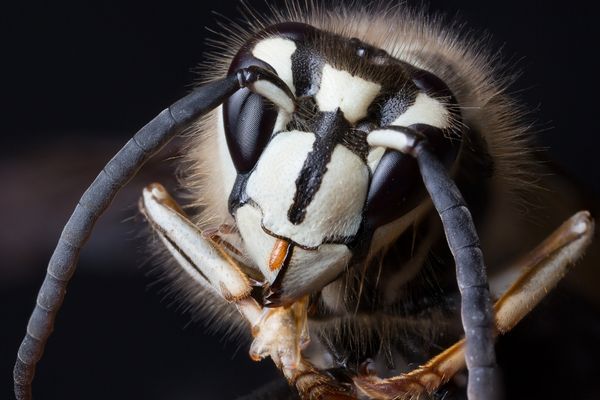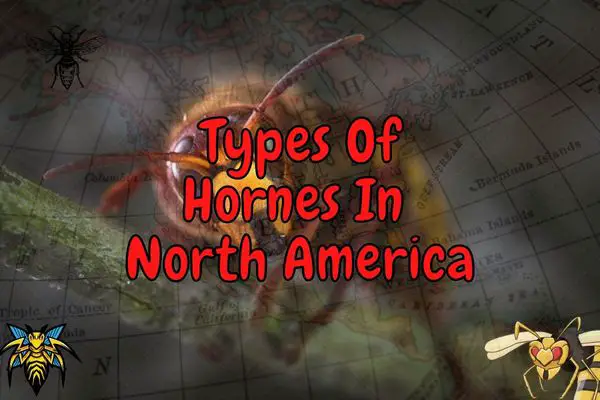Depending on the area, you might encounter different types of hornets in the US but many of these are not true hornets in a taxonomical sense.
In the US you will see many large wasps referred to as common European hornets, Asian giant hornets, Yellowjackets, and Cicada killer hornets, however, the vast majority of true Hornets you will encounter in the US are the European Hornets.
Even though the European hornet is the most numerous and practically the only real hornet in the US, it is actually invasive and not native to the US. In fact, no true hornet species really are!
There are, however, many types of large wasps that are named as or confused with hornets in the US, but many of these are actually yellowjackets.
Therefore I will also go through some of the species that are often considered, and even named, hornets here in this article.
Common European hornet
Common European hornets are common pests found across the United States. They are large wasps, up to 25 mm long. They live mainly in forests but will occasionally enter parks or other areas. They can be dangerous and should be handled properly.

They should not be left in the home or in containers that can attract children or pets. They should also be disposed of safely to avoid contaminating streams, ponds, and forage.
They were introduced in the late 19th century by European tradesmen sailing to New York. Since then they have been invasive to the US.
Common European hornets prefer wooded areas and urban areas. They have little tolerance for prolonged freezing temperatures, so their nests will usually be destroyed by late fall or early spring. For this reason, it is important to seal nests to prevent hornets from returning.
These insects can also damage crops. They are known to attack flowering trees and fruit crops. However, they do not attack people or pets. It is important to keep nests away from humans and pets until the brood is raised.
Asian (giant) hornet
The Asian hornet, also sometimes referred to as “giant hornet” is the largest wasp in the world, which is why it is also known as bird killer or killer wasp!

It can grow up to 2 inches long, which is twice as big as most other hornet species such as the European hornet or yellowjackets.
It is a true hornet species that is widespread in Asia, but may follow in the footsteps of its European cousin and establish in North America as well!
A new study from the University of Washington State Department of Agriculture in 2020 shows that Asian giant hornets may have been established as invasive species in both Washington, Orgeon and British Columbia. This is the first time that the species has been confirmed in the US.
The study uses mitochondrial DNA analysis to determine where the species is native. It found that two different introduced populations were related to the Asian giant hornets, indicating two distinct introductions.
Their presence in the Pacific Northwest poses a significant threat to the bee population as they mainly eat insects. The researchers don’t yet know how to control or eradicate the species from the United States. But they do know that they can destroy entire bee colonies.
Although the Asian giant hornet has not been widely confirmed in the US, there are several reports of its presence in the US. During the fall of 2019 and early 2020, a single colony was found in Washington state and destroyed.
In December, two dead hornets were found near the Canadian border in Washington. The next two confirmed cases are in spring 2020.
Though the Asian giant hornet is not yet a common pest in the US, its presence in these two locations may signal that it has spread to other parts of North America.
The Utah Department of Agriculture and Food is helping people to detect and remove the Asian giant hornet from their homes if spotted.
Yellow jacket hornets
Yellow jacket hornets are very large and aggressive wasps but are in fact not actual hornets even though they belong to the family Vespidae but not the genus of Vespa (true hornets).
I have included them here, as they behave pretty much as hornets do and many people, understandably, confuse these species with hornets!
The term yellow jacket or (yellowjacket hornets) is often used for large wasp species that nest in the ground.

The yellow jacket is a very common insect, especially in warm areas. It lives across the world, but is particularly prevalent in the southeastern part of the US.
They primarily feed on other insects, but will also eat fruits and carrion, and nectar from flowers. Because they are carnivorous, yellow jackets can travel up to a mile away from their nest. Yellow jackets also prey on honey bees and flies, which are attracted to their pollen and nectar.
Their sting is painful and they may sting multiple times. If you’re allergic to their venom, you can suffer a severe reaction. Additionally, if you swat at a yellow jacket, you might release its pheromone, which can be dangerous.
In the US, two species of yellow jacket hornets live. One is the eastern yellowjacket (V. maculifrons), which is common in the south, and the other is the southern yellowjacket (V. squamosa). Both species are pests, but in southern California, two species, V. vulgaris and V. germanica, are the most common.
Bald-Faced Hornets
The bald-faced hornet (Dolichovespula maculata) is a social insect and is found in many habitats, including urban areas or woodlands.
They are considered wasps or yellowjackets as they are not true hornets, even though their name as “bald faced hornets” suggests so.

Bald-faced hornets construct nests underground or in trees. They feed on insects, including caterpillars, flies, crickets, and other arthropods. The bald-faced hornet is the largest hornet species in North America.
Bald face hornets are important predators of many other insect species, serving as pollinators and scavengers, and preying on pests.
The bald faced hornet is a type of wasp that is native to North America. These insects are predators, and their diet consists mostly of other insects. However, they will also consume honey, fruit, and nectar.
Cicada Killers (Sphecius speciosus)
The Cicada killer is a large wasp that lives in the US. This insect has a long, hairy body with a red or black thorax. In contrast to the giant (Asian) hornets, the cicada killers have interrupted bright yellow stripes on their backs.

Its thorax is covered with three yellow bands, and its legs are red or black. The female cicada killer hornet is much smaller than the male. It has a yellow or black stinger. It lives in large colonies. It feeds on flower nectar and is common in the Eastern United States.
Cicada killer wasps have caused some alarm among Minnesotans. While they are not actually hornets, they are large ground-nesting wasps that hunt cicadas.
Although these wasps are found in the US, they are often confused with European hornets. Cicada killers can grow up to two inches long, while European hornets are typically just a few millimeters long.

While the male Cicada killer hornet is more aggressive, it isn’t a major threat to humans. While cicada killers don’t bite humans, their stings can cause allergic reactions in people.
How to Get Rid of Hornets in Your Backyard
Hornets can be a plague to have in your backyard and they can be dangerous to children and pets too.
And although a pretty hornet’s nest can bring in a significant amount of cash and the hornets can play a somewhat beneficial role in the ecosystem, they are mostly just destructive as they kill honey bees and disrupt natural pollination cycles.
The best way to get rid of hornets is to get rid of their nest, but you can also keep them away for a while without actually dealing with the nest itself.
Insecticide sprays are the preferred solution and come in eco-friendly natural forms as well. However, the synthetic ones are still the most effective ones for killing the hornets and yellow jackets but should be used only outdoors and with care.
Use insecticide sprays
The most effective way to kill hornets in your backyard is by spraying the nest. The best time to apply a hornet killer is at night, when it is dark. Apply the spray at the entrance of the nest and let it stay there for six to eight seconds.
Most sprays can reach up to 20 feet away so you do not have to worry about getting too close to the hornet or yellow jacket nest itself.
You can also make your own insecticide spray using a strong ammonia solution or essential oils mixed with soap and water. These are, however, not as effective as the commercially available sprays, but will work for minor infestations.
While the ammonia spray is effective in killing ground hornets, this solution is best applied after dark. Be sure to cover the mound when you pour the liquid. Repeat the application as needed. Another method is to use essential oils on the mounds.
Natural essential oils can also help to kill and keep hornets away. Essential oils can be mixed with two cups of water in a spray bottle so that you can spray the area where ground hornets are active. If the hornets are breeding in sparse patches, it is recommended to seed those areas with the spray as well.
Ultrasonic repellants
While this strategy will not actually kill the hornets, it will help to keep them away from your house or property. As a bonus, it also helps keep other pests away like mice, rats, mosquitos, as well as gophers and groundhogs (if placed outside).
They work via sounds so high frequency that you cannot hear them, but most insects and pests can! Placing one in your house will make sure that no hornets or wasps establish their nests there.
They also come in solar-powered versions for your backyard to keep hornets and wasps away from certain locations like your vegetable garden.
Use hornet traps
If you want to keep hornets away without using strong synthetic chemicals, there are also a few solutions such as traps or decoys.
Another effective method is to trap the hornets yourself with a homemade trap. You can make a trap out of a plastic 2-liter soda bottle, and place canned cat food or ripe fruit near the nest.
You can also put an empty can or lid near the nest. If you do decide to use a trap, you should keep your pet and other animals away from it as the dead hornets can still sting and are dangerous to touch.
Use nest decoys
You can also hang a paper bag in the back of your yard to keep the hornets away from your house (they will think it’s their nest!).
Also, a good way to prevent hornets from establishing on your property is to keep your yard neat and tidy by trimming back bushes and plants, and don’t place flowers near doors or pathways.
Also, be sure to cover trash cans and keep them closed. If you are allergic to hornets, you may want to hire a professional hornet removal service.
However, always be on the safe side! If you are allergic to wasp stings, you should seek professional help for the nest removal.
If you are not allergic, you can follow these tips to get rid of hornets in your backyard but remember to avoid disrupting the nest too much because it releases pheromones that trigger other wasps to perceive you as a threat.
Conclusion
Hornets vary in appearance and behavior, but many large colorful insects of the wasp family look like hornets. And although they are genetically not true hornets but other types of wasps like the yellow jackets, they are often referred to as hornets throughout the US.
Although most would agree that hornets are larger and more aggressive than other wasps, not all of the hornet-type wasps we tend to think of as hornets are true hornets.
The most common hornet in the US is actually a European import, the only true hornet you will likely see in North America. Although there are several other species that can be called “hornets”, they are more appropriately described as wasps or flies.
Although these wasps are found in the US, they are often confused with European hornets. Cicada killers can grow up to two inches long, while European hornets are typically just a few millimeters long.
While the male Cicada killer hornet is more aggressive, it isn’t a major threat to humans. While cicada killers don’t bite humans, their stings can cause allergic reactions in people.










